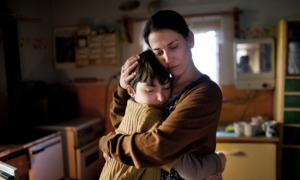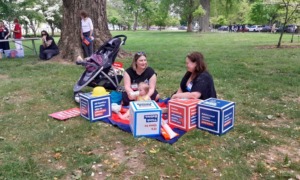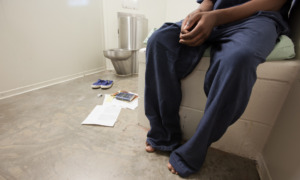Manitowoc, Wis.—The people who run Project Youth here realize that missing a grant application deadline is a fundamental mistake. When they did that a few years ago, they faced a financial shortfall that could have crippled the small agency serving troubled youth in the mostly rural communities of eastern Wisconsin.
Then something happened that would be stunning elsewhere but is almost expected here: Nearly two dozen other homeless and runaway youth agencies from throughout the state dug into their pockets and came up with $50,000 to bail out Project Youth.
That’s just one of the ways in which the very existence of agencies like Project Youth in sparsely populated areas around the state is possible, largely because of an arrangement that may be unique in the nation: The 23-year-old Wisconsin Association for Homeless and Runaway Services (WAHRS).
Through WAHRS, 23 agencies apply for federal and state money for runaway and homeless youth, then split up the grants according to a formula based on their needs. That means some large agencies in cities like Milwaukee get less money than they would on their own, while small agencies get money – and can provide services – that they otherwise would not.
“If we were to compete against Milwaukee one on one, we would not receive the dollars we have,” says Catherine Pape, who oversees the Manitowoc office of Project Youth, which also has programs in nearby Sheboygan and Fond du Lac. “If not for WAHRS, we would probably … have one small office serving clients primarily through the crisis line and [be] struggling to maintain funding.”
The arrangement is unique among agencies that receive basic center funding from the U.S. Family and Youth Services Bureau (FYSB), says Curtis Porter, the bureau’s acting deputy associate commissioner. The Hawaii Youth Network provides similar coverage, he says, but through a single, centralized grantee.
More typically, “everybody’s kind of in it for themselves,” says FYSB Associate Commissioner Harry Wilson, although most other states’ agencies try to carve up territory so they don’t “compete like Burger King and McDonald’s.”
The coalition has advantages and disadvantages, and there are certainly bumps along the way. How it works becomes evident on a visit to Project Youth’s office in this town of 32,000 on the often foggy shores of Lake Michigan.
Formula for Success
Youth who visit the two-story, former church rectory that houses Project Youth entertain themselves by playing foosball in the lobby, watching television in the living room, cooking in the kitchen or contributing to group art projects. The youths come with an array of issues, such as curfew disputes, drug abuse and pregnancy, says youth worker Ann Cyr, who manages the runaway program here. “A lot of our kids have been on the run – and if they haven’t, they’ve certainly thought about it,” she says.
Runaway services at Project Youth, an agency of Lutheran Social Services of Wisconsin and Upper Michigan, include a 24-hour runaway hotline, family mediation, community outreach and temporary shelter in licensed foster homes. Other services the agency provides include a mentoring program, transitional living for homeless youth and independent living for youth aging out of foster care.
While the agency serves more than runaways, Pape says that “without the runaway services, we would not have had a physical presence, and we would not have had the opportunity to gain that reputation of working well with youth. If we lost the dollars for the runaway services, I can’t say that we would be here.”
For those services they can thank the leaders of the four programs that served runaway youth in Wisconsin in 1979: Pathfinders for Runaways and Walkers Point Youth and Family Center in Milwaukee, Innovative Youth Services (now SAFE Haven Youth Shelter) in Racine, and Youth Services Briarpatch in Madison. In 1981, leaders of those programs presented the state government with a plan for statewide coverage. Thus WAHRS was born, with 12 members.
Under the coalition, each agency receives a percentage from the pool of state and federal funds for core “basic center” runaway services; members apply individually for the pre-set amounts. The federal money comes from FYSB through the federal Runaway and Homeless Youth Act ($813,495 for Wisconsin in fiscal 2003; $44 million nationwide) and from the state Department of Health and Family Services ($495,600 this year).
For example, the two Milwaukee agencies, Pathfinders and Walkers Point, received 13.39 percent each (about $175,000) of the combined $1.3 million for fiscal 2004, while Project Youth received 4.66 percent (about $60,000) to split among its three offices. Agencies apply for private funds outside of WAHRS, which covers 62 of the state’s 72 counties.
Denis Murstein, executive director of the Youth Network Council in Chicago, says the tight-knit formula is unique among state associations he knows of. “All of the other coalitions are a little more loosely federated,” he says, meaning that they compete more for money.
That’s not to say that the Wisconsin agencies easily agreed on how to divide the money. “For all that one can talk about working together and collaborating and partnering with other agencies, when it comes to money, that’s where you get down to nitty-gritty stuff,” says Walkers Point Director Andre Olton, one of the prime movers behind WAHRS.
The founding agencies encouraged everyone to put their concerns on the table and ended up with quite a list. “There was no shortage of people wanting to speak out,” Olton, now WAHRS treasurer, says with a hearty laugh.
The percentage formula is loosely based on the number of youth each agency serves, the type of shelter it provides and the number of counties it covers. The formula has been adjusted numerous times for special circumstances, says WAHRS Executive Director Patricia Balke, who oversees a staff of three and a budget of $675,000. For example, she says, one year members agreed to split $50,000 in unexpected federal funds among the five smallest agencies, all of which had been struggling.
The biggest chunk of WAHRS’ budget, $294,000, comes from AmeriCorps; WAHRS is a grantee, but the workers are sent to coalition member agencies. By banding together, the coalition members are in a stronger competitive position to get the grants.
Sharing the Payoffs
Coalition members see many advantages, starting with the belief that more youth are served because the state has more agencies, with greater financial stability, than it would have without WAHRS.
Wisconsin would probably have “not too many more than four” programs for runaway and homeless youth, says Tim Baack, president of WAHRS and associate executive director of the Counseling Center of Milwaukee, which operates Pathfinders.
“And there would be have been lack of stability,” Olton says. He notes how in other states, “programs can hang onto their grants for awhile, sometimes they’ll get decreases, sometimes new programs will be funded, old programs will be de-funded.”
Without WAHRS, “we would have to spend that much more time fund raising, and a far greater percent of our funds would be soft dollars,” says Marilyn Pape (no relation to Catherine Pape), program director for Project Youth in Sheboygan. With the relative stability of government funding through WAHRS, she says, “we can predict our level of services. We can hire staff with some confidence.”
WAHRS also provides grant-writing assistance for basic center and other funding. Olton notes that Executive Director Balke pulls together some of the smaller agencies to apply for grants together, making it easier for them to compete against larger applicants.
The benefits go beyond money. WAHRS holds staff training sessions and an annual conference with training. These are especially popular among rural agencies, Olton says, because “they don’t have other training opportunities.”
The larger programs have also trained the 25 AmeriCorps workers who fan out across the state, mostly to smaller programs, says John Babbitt, who coordinates those workers for WAHRS.
The benefits of WAHRS are perhaps less obvious for larger programs. Baack readily agrees that they could receive a higher percentage of the state and federal funding if they were free from the formula constraints of the coalition.
But the virtually statewide coverage of homeless and runaway services has advantages. For one thing, Olton says, it provides clout in the state capital, Madison. “There has been many a time when the governor has wanted to veto runaway dollars,” he says, referring at least partly to Tommy Thompson, who reduced funding during most of his decade as Wisconsin’s governor before becoming U.S. secretary of Health and Human Services – the department that includes FYSB.
“Or we have wanted to get increases” in funding, he adds. “We have clout throughout the state to be able to call legislators and say, ‘Support the bill.’ ”
This potentially expanding pie of runaway dollars means the larger agencies do not necessarily lose money “in the bigger picture,” Baack says. “It gets us a more powerful voice when it comes to advocacy, when it comes to legislation.”
The formula also provides stability for programs, Olton says, “instead of having to compete within our programs, and some [agencies] win some years and some lose other years.”
If a runaway youth cannot find services in his area, he might hit the road for one of the larger cities, Baack says. “If the program in Superior, Wis., were to close and those youth end up coming to metro Milwaukee, we are much more disadvantaged to try to help them than their local program would be,” he says. “So we all lose if that program were to fold.”
Youth who do come to the cities “can be hooked up with the program that’s closest to their community,” Olton says.
Another benefit of WAHRS for large agencies such as Briarpatch, says Program Director Aaron Backer, is the sharing of best practices. But larger programs probably could take care of themselves fiscally, he says. “In some ways, we don’t need the organization.”
In fact, Murstein, of the Youth Network Council, notes that WAHRS probably limits the growth of larger agencies, “unless there’s some kind of bubble, or opportunity” to apply for new funding.
But a few incidents demonstrated how some agencies really need the coalition.
Sharing the Pain
The spirit of the coalition has been tested on three occasions.
Both Project Youth and SAFE Haven in Racine have received one-year $50,000 bailouts from the coalition. The money was needed, says WAHRS’ executive director Balke, because Project Youth missed a grant application deadline and SAFE Haven didn’t get expected money due to a poor grant review.
In such cases, Olton says, each agency kicks in an amount based on the percentage formula to fill the gap. “We expect programs to be responsible in administering their grants,” he says. “When you’re sitting around the table with your peers and saying, ‘I really need help’ … other programs are going to say, ‘Well, we’re willing to do this – maybe. But what’s the impact on us, and for how long? How did you get in this fix? How can you get yourself out of this fix?’ ”
Jim Huycke, executive director of SAFE Haven, recalls his peers saying, “Look, we can’t bail out every program that screws up and can’t get funded.” He adds, “It wasn’t like this was a long, drawn-out process. Somebody said, ‘Jim should leave the room so we can discuss this freely,’ but 30 seconds later, I was back in the room.”
“Tough questions were asked, and appropriately so,” recalls Marilyn Pape, with Project Youth in Sheboygan.
Project Youth was temporarily on the losing end of another incident, this one demonstrating what might have happened if WAHRS had not formed.
Programs apply for federal funding every three years, and for fiscal 2002 only Project Youth, Pathfinders in Milwaukee and Briarpatch in Madison were due to apply. A new grant writer at Briarpatch applied to FYSB for the maximum $200,000 that an agency can receive under the Runaway and Homeless Youth Act.
FYSB, which is not bound by WAHRS’ formula, awarded the full amount to Briarpatch, gave Pathfinders more than it sought and denied funds for Project Youth.
The coalition approach was put to the test. “People didn’t realize it was an honest mistake,” Balke says. “There was some misunderstanding, and some, ‘Did they intentionally go for the gusto at someone else’s expense?’ ”
“It was a difficult time,” says Marilyn Pape.
The executive director of Briarpatch “immediately realized what had happened” and worked out a $46,130 subcontract with Project Youth, Balke says. Pathfinders did the same for $13,957, bringing all three agencies back in line with the WAHRS formula and cooling off the hard feelings.
“What would have happened in other states is that [Project Youth] would have shut down,” Balke says.
How could an agency make such a mistake? Balke says Briarpatch’s executive director (who is no longer there) did not review the application “as closely as he should have.” Backer, the program director at Briarpatch, says the grant writer did not realize that applying for the $200,000 would hurt another agency. He says the writer’s contact at FYSB had said: “If you don’t ask for it, you won’t get it.”
Porter, the FYSB contact in question, says he did not encourage Briarpatch to apply for the full amount. “I just told them, ‘Anybody is eligible to apply for the funding dollars,’ ” he says. “That’s their own personal agreement, how they deal with it in Wisconsin.”
At Project Youth, Marilyn Pape came away with a reassuring feeling from the coalition that “we’re in this together, which is pretty profound.
Because there was a principle involved larger than the dollars.”
For the state, the bottom line is that more youth are served by more agencies because of WAHRS. “It ensures that youth and families don’t have to go as far” for services, says Emily Curtis, runaway services coordinator for the state’s Department of Health and Family Services. “I don’t think there would have been service agreements in 62 counties without WAHRS.”
“It seems like a promising thing to do,” says Wilson, the associate commissioner at FYSB, whose years of youth work include serving as dean of students at Michigan’s Starr Commonwealth Schools.
“If you have a strong association that’s willing to coordinate all that and encourage partnerships, it probably wouldn’t be too difficult.”
That is, as long as everyone went in with a communal mindset. “It’s part of our socialist history,” Baack says with a laugh, referring at least partly to Milwaukee’s four decades of socialist mayors in the early to mid-20th century.
For Huycke, executive director of SAFE Haven, the primary motivation is “altruism.”
“That’s the only explanation there really is,” he says. “You’re sacrificing for the good of the whole.”
Resources
Patricia Balke, Executive Director
Wisconsin Association for Homeless and Runaway Services (WAHRS)
2318 E. Dayton St.
Madison, WI 53704
(608) 241-2649
pbalke@scglobal.net
www.wahrs.org
Catherine Pape
Project Youth
721 Park St.
Manitowoc, WI 54220
(920) 682-2816
mailto:cpape@lsswis.org%20
























